Site pages
Current course
Participants
General
Module 1. Perspective on Soil and Water Conservation
Module 2. Pre-requisites for Soil and Water Conse...
Module 3. Design of Permanent Gully Control Struct...
Module 4. Water Storage Structures
Module 5. Trenching and Diversion Structures
Module 6. Cost Estimation
Lesson 3. Soil Conservation Approaches
3.1 What are Soil Conservation Approaches?
The top soil layer contains mostly organic matter and nutrients which are very useful for plant growth. In order to get better plant growth, the top soil layer must be protected from wind and water erosion. Measures taken for protecting the top soil layer are called soil conservation measures. These measures protect top soil either through reducing the impact of erosive agents (water and wind) or by improving the soil aggregate stability or surface roughness. The soil conservation measures can be broadly grouped into three categories namely, biological, mechanical, bio-engineering etc.
3.2 Biological Control of Soil Erosion
In this, erosion is controlled through crops or vegetation - that is by nature's way of doing things. It means that cultivation should be done in suitable way by adopting measures, which shall minimize erosion. Improper cultivation leads to severe soil erosion. A permanent vegetative cover is the best protection for soil. Studies have shown that bare ground allows four times more soil erosion compared to permanent plant covered ground. Therefore, vegetation plays an important role in controlling soil erosion and can be used as effective erosion control measure. In this method we try to plant such species, which are capable of holding soil strongly and can survive in very adverse soil condition. The main principle of biological control is to prevent high velocity of water and conserve water within the soil. In biological control following method can be adopted.
3.2.1 Mulching
Mulching is the covering of the soil with crop residues such as straw, maize, stalks etc. These cover protects the soil from the rain drop impact and reduces the velocity of runoff and wind. It is also useful as an alternative to cover crop in dry areas where a cover crop should compete for moisture with the main crop. Fig. 3.1 shows application of mulch in agriculture.
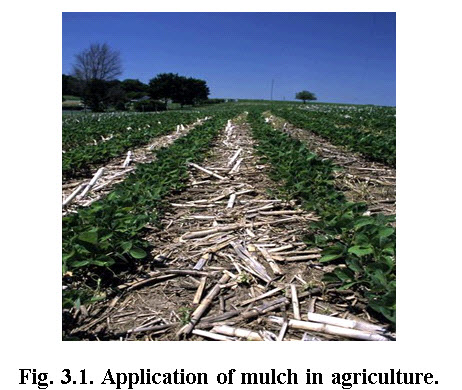
(Source: NRCS photo gallery NRCSIA04023.jpg, accessed on Jan. 15, 2013)
3.2.2 Agro Forestry
Trees can be incorporated within a farming system by planting them on terraces, contour bounds and as ornamental around the homestead. This reduces soil erosion and provides additional needs to the farmers. Fig. 3.2 shows agroforestry system in which poplars are in cultivated along with, turmeric, mango and litchi.
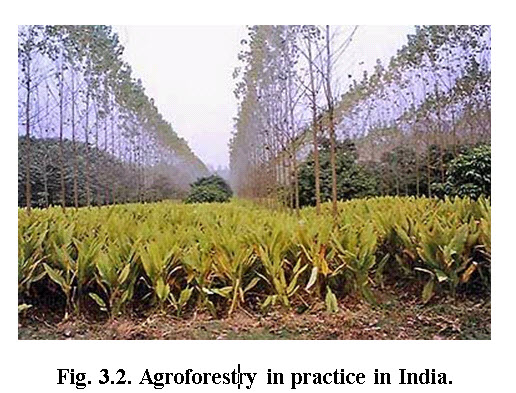
(Source: http://www.fao.org/docrep/008/a0026e/a0026e02.htm, accessed on Jan. 15, 2013)
3.2.3 Reforestation/Afforestation
Reforestation: Is a process of restocking the existing depleted forests and woodlands either naturally or intentionally. Reforestation can be used to improve air quality, mitigate global warming and rebuilt ecosystem by controlling soil erosion. Forestation/plantation plays the major role in erosion control on gullies areas and landslides.
3.2.4 Crop Rotation
It may be defined as a more or less regular succession of different crops being grown on the same piece of land. Rotation of crop reduces erosion and increases the fertility of soil by different crops being grown on the same patch of land so as to enable intake of plant food from different layers of soil. In addition crop rotation increases crop yield and net profit while it reduces use of chemicals as well as water pollution. For example, leguminous crops like pulses are grown alternately with wheat, barley or mustard. Fig. 3.3 shows typical layout for crop rotation system.
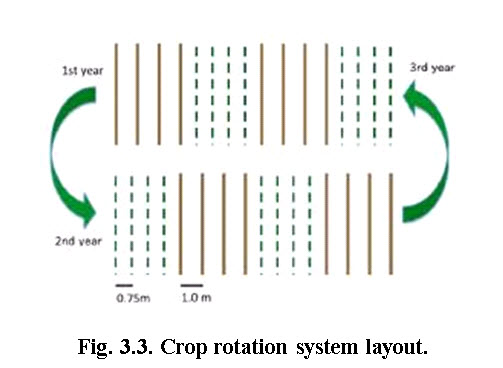
(Source:http://www.jircas.affrc.go.jp/english/publication/highlights/2010/201002.html, accessed on Jan. 16, 2013)
3.2.5 Mixed Cropping
In this system two or more than two crops are raised in the same land and in the same time. Mixed cropping is also known as inter cropping or co-cultivation. Mixed cropping system offers several benefits which include better utilization of soil nutrients, low weeds and insect pests, resistance to climate extremes, increase in overall productivity and use of limited resources to the fullest extent.
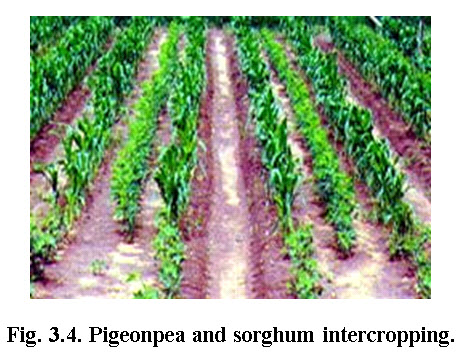
(Source:http://vasat.icrisat.org/crops/pigeonpea/prod_practices/Crop%20Systems/intercropping.htm, accessed on Jan 16, 2013)
3.2.6 Cover Cropping
Cover crops are grown as a conservation measure either during off-season or for ground protection under trees. These also add organic matter to soil. All these provide good cover from erosion control point of view and at the same time furnish hay or fodder and serve as soil building crops. These cover crops are also grown under trees to protect the soil from the impact of water drops falling from the canopy particularly important for tall trees like rubber where height of fall is more.
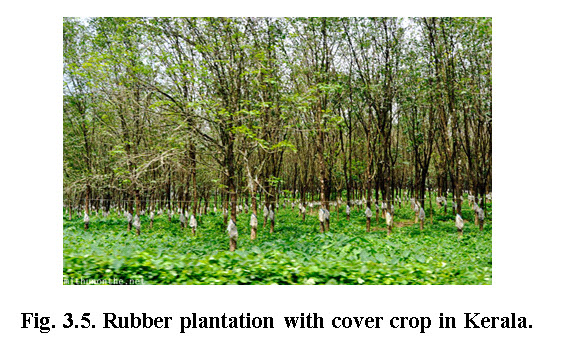 (Source: http://mithunonthe.net/2012/02/18/thekkady-boat-ride-periyar-lake-national-park-photos, accessed on Jan 16, 2013)
(Source: http://mithunonthe.net/2012/02/18/thekkady-boat-ride-periyar-lake-national-park-photos, accessed on Jan 16, 2013)
3.2.7 Contouring
Contouring refers to applying all tillage practices, such as, ploughing, planting, cultivation & harvesting on the contour i.e. across the slope rather than up and downhill. In regions of low rainfall, this helps in conservation of moisture and in humid areas reduces erosion by reducing surface runoff. The furrows between the ridges developed by contour tillage operations catch and hold the water, thereby, checking the high water velocity, which erodes soil and causes sheet, rill or gully erosion. On steep slopes or under conditions of high rainfall intensity and soil erodibility, contour farming alone will increase gullying because row breaks may release stored water. Under such conditions they are supplemented by strip cropping.
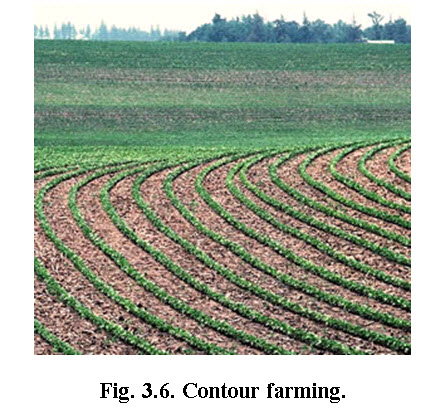
(Source:http://www.mda.state.mn.us/protecting/conservation/practices/contourfarm.aspx, Accessed on Jan 17, 2013)
3.2.8 Strip Cropping
It is the practice of growing alternate strips of row crops and inter-tilled crops in the same field. In this, the crops are grown in strips at right angles to the slope of land. Erosion is largely limited to row - crop strips and soil removed from these is trapped in the next strip, which is generally planted with a leguminous or grass crop. Strip cropping reduces soil erosion due to both water and wind erosions, and water borne contamination. Strip cropping is generally of three types, namely, contour strip cropping, field strip cropping and buffer strip cropping.
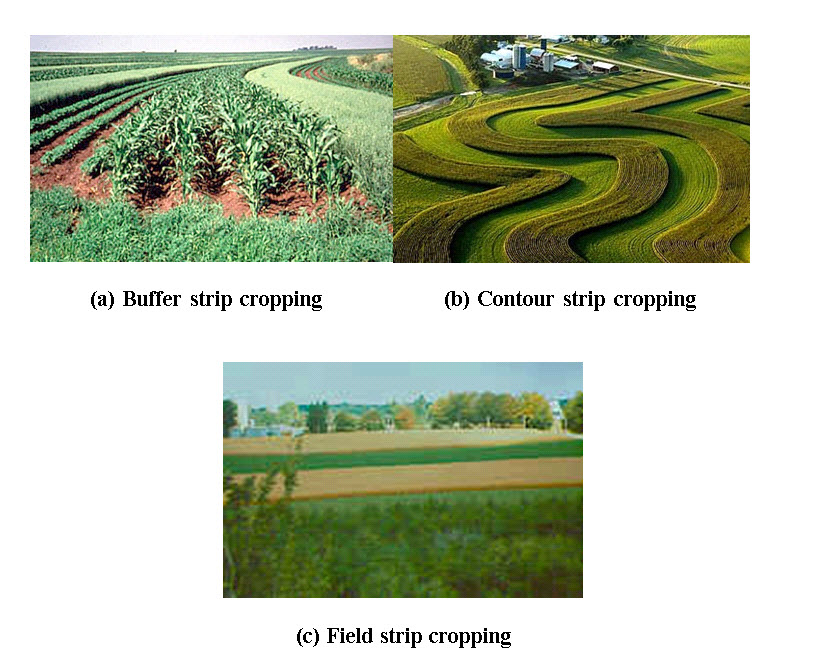
Fig. 3.7. Strip cropping. (Source:http://www.takdangaralin.com/science/earth-science/what-is-soil-kinds-of-soil-soil-erosion/ for a and b,
http://www.omafra.gov.on.ca/english/environment/bmp/afirstlook/prot_surface.htm for c, Accessed on Jan 17, 2013)
3.2.9 Conservation Tillage
Conservation tillage is any method of soil cultivation that leaves previous crops residue on field before and after planting the next crop. It decreases soil erosion, runoff, water pollution, CO2 emission and also fossil fuel. Conservation tillage methods include no-till, strip-till, ridge-till and mulch-till. No-till involves planting crops directly into residue that has been not at all, whereas in strip-till narrow strips are tilled and the rest of the field left untilled (strip-till). In Ridge-till row crops are planted directly on permanent ridges of 10-15 cm by clearing previous year’s crop residues form ridge tops only. Mulch-till is any other reduced tillage system that leaves at least one third of the soil surface covered with crop residue.

Source: http://www.sciencedirect.com/science/article/pii/S0261219406002675, accessed Jan 17, 2013)
3.3 Mechanical Methods
Mechanical practices are engineering measures used to control soil erosion from sloping land surface. The purpose of constructing the mechanical structures is to (1) to increase the time of stay of runoff water to increase the infiltration time for the water, (2) to break the land slope ,thus reducing the velocity of the runoff water. Bunds and terraces are mechanical structures used to control the soil erosion.
A terrace is an earth embankment, constructed across the slope to control runoff and thus reduces the soil erosion. Terraces are act as a slope divider. The terraces can be classified in to two groups. Bench terrace reduces land slope whereas broad base terrace removes or retains water on sloping land. The original bench terrace system consist of a series of flat shelf-like areas that convert a steep slope of 20 to 30 percent to a series of level, or nearly level benches. Broad base terrace is broad surface channel or embankment constructed across the slope of rolling land. On the basis of primary function the broad base terrace is further classified as Graded or Channel Type and Level or Ridge Type. The primary function of graded terrace is to remove excess water in such a way as to minimize erosion. Erosion is controlled by reducing the slope length and conducting the intercepted runoff to a safe outlet at a non-erosive velocity. The primary function of level terrace is moisture conservation. In low to moderate rainfall regions they trap and hold rainfall for infiltration into the soil profile. They can be used even in high rainfall areas if the soil is permeable.

(Source http://secretagentworms.org/vault011.html (a), http://www.ehow.com/info_8742228_terrace-farming.html (b) accessed on Jan 18, 2013)
Based on the functional requirements, they can be divided in to two types: Contour bunds - storage of water and Graded bunds - safe disposal of excess water.
Bunds are similar to the terraces which have narrow base. Generally two types of bunds are practiced namely graded bunds and contour bunds. Graded bunds are used where rainfall is very high and contour bunds are used where rainfall is low. The choice of the type of the bunds depends on the slope, rainfall, soil type and the purpose of making the bund in the area. Contour bunds are constructed following the contour as closely as possible. A series of such bunds divide the area into strips and acts as barriers to the flow of water, thus reducing the amount and velocity of the runoff. Graded bunds are used for safe disposal of excess runoff in high rainfall areas and regions where the soil is relatively impervious. They may have uniform grade or variable grade.
3.4 Bio-Engineering Method
Biotechnical engineering techniques are combined with biological knowledge to build geotechnical and hydraulic structures and to secure unstable slopes and banks. Whole plants or their parts are used as construction materials to secure unstable sites, in combination with other (dead) construction material. Biotechnical methods using willows and other woody plants are especially appropriate for constructing several soil conservation structures. This structure stabilizes the soil, reduce the movement speed of running water, and thus reduce the surface erosion. Maintenance of these structures is a very important aspect as compared with other methods of soil conservation. The maintenance cost of bioengineering structures is somewhat high in initial period and later on it becomes very less. Bio engineering methods of soil conservation have the following advantages.
Immediately effective after installation
Material easily available as structures also serves as a nursery for new plant material
Flexibility in preparation and protection
Bio engineering methods also have some disadvantage
High demand on material and labour
Occasionally thinning of thicket necessary
Labour intensive
Table 3.1 presents brief description and applications of some of the bio-engineering measures.
Table 3.1. Bio-Engineering techniques and their description
|
Technique |
Application |
Description |
|
Wattle fence |
Over-steepened slopes where vegetation cannot naturally establish |
Long cuttings (e.g. willow) laid horizontally and supported with larger vertical plant stakes or rebar. Soil is filled in behind the fence; creates a series of terraces. |
|
Live bank protection |
Along stream banks, to protect against further erosion. |
Wattle fences are contoured around bends in the stream, in areas that are susceptible to erosion; soil is then backfilled behind the fences. |
|
Live palisades |
Adjacent to a stream or river where the natural vegetation has been removed. |
Large posts of a tree such as cottonwood are sunk in trenches some distance back from the edge of the stream. |
|
Brush layering |
Stabilizing shallow earth slumps and loose soil slopes and gullies |
Benches are excavated in the slope, willow branches are laid, on a slight angle, on the benches; branches are covered with soil, with just the tips sticking out. |
|
Coconut fiberfascines |
Stabilizing the base of a stream bank or shoreline. |
Fascines (fibre “log rolls”) are placed along the base of a bank; they collect sediment and help to stabilize the bank; riparian vegetation may then be planted in and alongside the roll. |
|
Prevegetated mats |
Lakeshores and wetlands |
Plants are grown on mats made of a slowly biodegradable material such as coconut fibre; the mats are then simply placed on the slope. |
|
Live gravel bar staking |
Unnaturally large gravel bars amid braided streams (caused by upstream resource activities) |
Using an excavator, live stakes are inserted in the gravel bar, in order to start recolonization of natural vegetation, and a return to a single stream channel. |
(source:http://www.crd.bc.ca/watersheds/protection/howtohelp/bioengineering.htm)
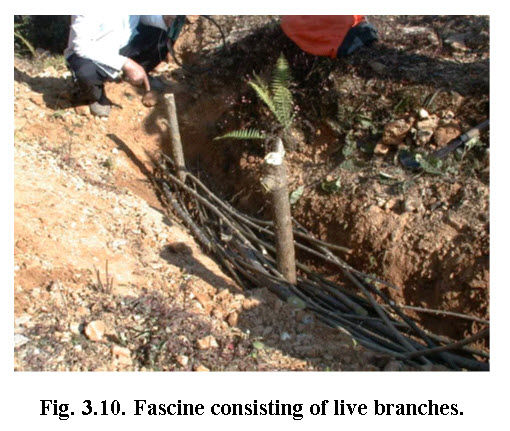
(Source: Himachal Pradesh State Road Project Draft Report on Bio Engineering Plan for Phase –II 163 km)
References
Michael, A.M. and Ojha, T.P. (1978). Principals of Agricultural Engineering. Vol. II, Jain Brothers, New Delhi, India
Morgan, R.P.C. (2005). Soil Erosion and Conservation, Third edition, Blackwell Publishing, UK.
Schwab, Glenn O., Frevert, Richard K., Edminster, Talcott W., and Barnes, Kenneth K. (1981). Soil and Water Conservation Engineering, Third edition, John Wiley and Sons, New York.
Sharda, V.N., Juyal, G.P., Prakash, C. and Joshi, B.P. (2007). Training Manual on Soil Conservation and Watershed Management, Vol II: Soil and Water Conservation Engineering, CSWCRTI, Dehradun, Saraswati Press, Dehradun, India.
Suresh, R. (1997). Soil and Water Conservation Engineering, Second edition, Standard Publisher Distributors, Delhi, India.
Internet References
http://www.mda.state.mn.us/protecting/conservation/practices/constillage.aspx
http://www.fao.org/docrep/008/a0026e/a0026e02.htm
http://www.jircas.affrc.go.jp/english/publication/highlights/2010/201002.html
http://vasat.icrisat.org/crops/pigeonpea/prod_practices/Crop%20Systems/intercropping.htm
http://mithunonthe.net/2012/02/18/thekkady-boat-ride-periyar-lake-national-park-photos
http://www.mda.state.mn.us/protecting/conservation/practices/contourfarm.aspx
http://www.takdangaralin.com/science/earth-science/what-is-soil-kinds-of-soil-soil-erosion
Suggested Readings
Michael, A.M. and Ojha, T.P. (1978). Principals of Agricultural Engineering. Vol. II, Jain Brothers, New Delhi, India
Morgan, R.P.C. (2005). Soil Erosion and Conservation, Third edition, Blackwell Publishing, UK.
Schwab, Glenn O., Frevert, Richard K., Edminster, Talcott W., and Barnes, Kenneth K. (1981). Soil and Water Conservation Engineering, Third edition, John Wiley and Sons, New York.
Sharda, V.N., Juyal, G.P., Prakash, C. and Joshi, B.P. (2007). Training Manual on Soil Conservation and Watershed Management, Vol II: Soil and Water Conservation Engineering, CSWCRTI, Dehradun, Saraswati Press, Dehradun, India.
Suresh, R. (1997). Soil and Water Conservation Engineering, Second edition, Standard Publisher Distributors, Delhi, India.